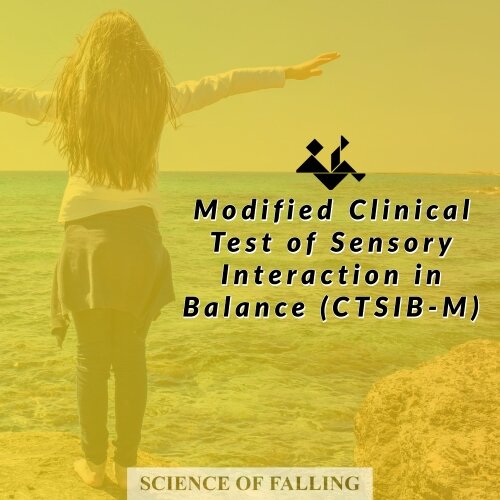Modified Clinical Test of Sensory Interaction in Balance (CTSIB-M)
Updated: 3/4/25
Essential Points:
CTSIB-M Overview: The Modified Clinical Test of Sensory Interaction in Balance (CTSIB-M) assesses how well a patient uses their balance systems (somatosensory, visual, and vestibular) under various conditions, providing insight into potential impairments and the need for further testing or sensory re-weighting exercises.
Testing Conditions and Interpretation: The test involves four conditions that manipulate sensory input: eyes open/closed on both firm and compliant surfaces. Excessive sway in specific conditions helps identify which balance system may be impaired, guiding appropriate follow-up testing and interventions.
Practical Applications: Even if a patient achieves the full 120-second score, excessive sway indicates potential balance issues that should be explored further, and dynamic balance testing is recommended to complement the static nature of the CTSIB-M.
Curious about trying the CTSIB-M for yourself or your clients? Explore my interactive web app, which guides you through the test, collects scores, and provides results in just 5-10 minutes.
For best accuracy, especially when working solo, I suggest using your phone to easily press the buttons while working through the test positions.
The Modified Clinical Test of Sensory Integration on Balance (CTSIB-M) is a cheap and accessible clinical test that helps determine how well a patient uses sensory input during various balance activities via their three sensory balance systems. These systems include the somatosensory system, visual system, and vestibular system. You can read more about these balance systems here. Through this test we can generate a general understanding of the patient’s static balance impairments, which balance systems warrant further specific testing, and if we need to work with the patient on sensory re-weighting for improved balance performance.
CTSIB-M Overview
This test requires a flat surface and a compliant surface (such as a foam pad). During the test, 4 conditions are performed that change the levels of input between the three balance systems. The four conditions are as follows:
1. Eyes open/Firm surface
2. Eyes closed/Firm surface
3. Eyes open/Compliant surface
4. Eyes closed/Compliant surface
During these conditions, the patient maintains their arms at their side. Each condition is timed for 30 seconds. If a patient opens their eyes (during an eyes closed condition), moves their arms from their side, or loses their balance the timer is stopped. If the patient does not achieve the full 30 seconds in a condition, they are allowed two more trials of that condition. If multiple trials are needed, those condition trial times are averaged for that condition’s score. Once all conditions are tested, the therapist will then add up their total times (30s max per condition) for a score out of 120s.
Interpreting Findings for Each Condition
Although the test gives us a timed score, we can gain copious amounts of information based off the patient’s performance in each condition. Each condition weights sensory input differently allowing the therapist to gain insight into which systems may be impaired or overworking.
The contributions of the somatosensory, vestibular, and visual systems on balance control are not fixed ratios but are dynamically adjusted depending on the sensory context. (1, 2) On a firm surface, balance is primarily maintained by somatosensory feedback, with vestibular and visual inputs also playing important roles. In contrast, when standing on a compliant surface, the system adapts by upweighting vestibular input and relying more on visual cues, while the contribution from somatosensory signals is reduced due to the altered reliability of the information. A 70% somatosensory - 20% vestibular - 10% visual scheme is often cited in research and academia as the breakdown of these systems under normal conditions. Unfortunately, this idea is a highly oversimplified demonstration of the weights of each system for teaching purposes, and these exact values have not been found specifically in any research.
Below we will discuss briefly what additional information we can glean from each condition.
Condition 1 – Eyes open/Firm Surface
In Condition 1, eyes open on a firm surface, all three balance systems are fully engaged in the activity and thus this condition is not very specific. If a patient demonstrates excessive sway this may mean that their somatosensory system is impaired, and that their vestibular and visual systems are not compensating well. We can assume that the balance problem is most likely multi-factorial. The next three conditions will help flesh this out more. Having no sway does not tell us much due to all three systems being involved and able to compensate for one another.
The takeaway from this condition is that if excessive sway exists, we need to at least conduct somatosensory specific testing. We should also continue with the next three conditions to pin down which specific systems are potentially impaired.
Condition 2 – Eyes Closed/Firm Surface
In Condition 2, eyes closed on a firm surface, we have purposely impaired the visual system. In this condition sensory re-weighting will occur shifting the brain over to utilizing the somatosensory and vestibular systems to a higher degree.
Increased sway in this condition may indicate that the patient was visually dominant in Condition 1 and used vision to a higher degree than normal (even if the somatosensory system is intact), or that the somatosensory system is impaired, and the patient compensated with vision in condition 1. Again, this should steer us in the direction of conducting specific somatosensory testing.
If somatosensory testing comes up with negative findings, we can assume that the patient is visually dominant. If this is true, the patient will be appropriate for sensory re-weighting exercises towards the somatosensory system thus reducing their excessive reliance on their vision. If the somatosensory system is impaired, we want to work on strategies to improve the visual and vestibular systems effectively improving compensatory strategies.
Finally, if the patient demonstrates equal amounts of sway between conditions 1 and 2, we can assume that both the somatosensory and visual systems may be impaired. We can make this assumption due to the relative strength of each system on a firm surface. Due to the large amount of balance control the somatosensory system gives us on a firm surface, any sway on this surface should pique our interest in somatosensory dysfunction. If the visual system was fully intact, it should compensate for any somatosensory dysfunction and reduce sway with eyes open versus eyes closed. Consequently, since we are reporting equal sway in both conditions 1 and 2, we can assume the visual system is impaired and unable to compensate in condition 1. If this finding occurs, we should also have additional testing for the visual system. If visual deficits are found it is appropriate to refer out.
Condition 3 – Eyes open/Compliant surface
In Condition 3, eyes open on a compliant surface, we purposely impair the somatosensory system with the compliant surface. In this condition sensory re-weighting occurs naturally increasing our use of the vestibular and visual systems. Abnormal sway can indicate that the patient has relied solely on somatosensory information for balance (more likely if Condition 1 and 2 were normal), the visual system is impaired, or the vestibular system is impaired.
Condition 4 – Eyes closed/Compliant surface
In condition 4, eyes closed on a compliant surface, we are essentially testing the vestibular system solely as we have purposely impaired the other two balance systems. If excessive sway occurs in this condition, we should conduct a basic vestibular system screening in addition to any other system that we believe may be impaired.
If sway in this condition is the same as in condition 3, we can then again assume vision is impaired and is unable to compensate in eye open conditions. Visual testing should be done as a follow up.
Final Thoughts
Although the CTSIB-M is a timed test, we can gain both information and follow up direction in our examine process. Even if a patient is able to achieve the full score of 120s, any excessive sway should be noted and followed up. You may need to read this article a few times to truly grasp and understand what each condition can tell us. Additionally, due to the static nature of the CTSIB-M this test should also be followed up with dynamic balance testing if appropriate.
Resources
1. Peterka R. Sensorimotor Integration in Human Postural Control. J Neurophysiol. 2002;88(3):1097-1118. doi:10.1152/jn.2002.88.3.1097
2. Peterka R, Loughlin P. Dynamic Regulation of Sensorimotor Integration in Human Postural Control. J Neurophysiol. 2004;91(1):410-423. doi:10.1152/jn.00516.2003
Further Resources for the CTSIB-M
Thanks for reading and I hope you learned a few new nuggets! Have you ever used the CTSIB-M in your clinical practice? If so what information did you find valuable from the test? Do you need further clarification for any of the information presented in this article? Let me know below in the comments.
Happy falling!






